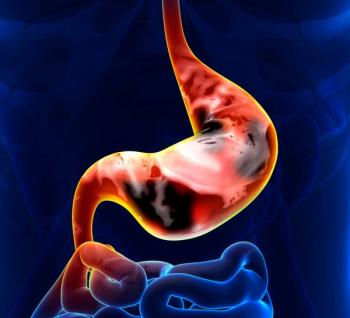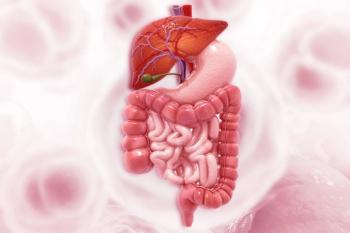
Oncology NEWS International
- Oncology NEWS International Vol 12 No 12
- Volume 12
- Issue 12
Chemo-RT Before Surgery Ups Rectal Cancer Outcomes
SALT LAKE CITY-Compared with patients with locally advanced rectal cancer who receive chemoradiotherapy postoperatively, those who receive chemoradiotherapy preoperatively have a downstaging of their cancer at surgery, a lower rate of local recurrence, a higher rate of sphincter preservation when tumors are low lying, and a lower rate of adverse effects, according to early results of the German Rectal Cancer Study (CAO/ARO/AIO-94). Lead author Rolf Sauer, MD, director of the Strahlenklinik, Erlangen, Germany, presented the results at the 45th Annual Meeting of the American Society for Therapeutic Radiology and Oncology (ASTRO plenary session, abstract 2).
SALT LAKE CITYCompared with patients with locally advanced rectal cancer who receive chemoradiotherapy postoperatively, those who receive chemoradiotherapy preoperatively have a downstaging of their cancer at surgery, a lower rate of local recurrence, a higher rate of sphincter preservation when tumors are low lying, and a lower rate of adverse effects, according to early results of the German Rectal Cancer Study (CAO/ARO/AIO-94). Lead author Rolf Sauer, MD, director of the Strahlenklinik, Erlangen, Germany, presented the results at the 45th Annual Meeting of the American Society for Therapeutic Radiology and Oncology (ASTRO plenary session, abstract 2).
"Because of the radiobiological advantages that preoperative radiotherapy or chemoradiotherapy provides, the German Rectal Cancer Study Group in the mid-90s started this protocol, which compared neoadjuvant vs adjuvant chemoradiotherapy," Dr. Sauer said.
Patients were enrolled in the phase III randomized trial from 26 institutions; they had stage II or III rectal cancer (T3/T4 or N-positive disease), as diagnosed by endorectal ultrasound or the Mason procedure, and were younger than 75 years, Dr. Sauer said.
They were assigned to preoperative or postoperative concurrent chemotherapy and radiation therapy, consisting of 50.4 Gy in 1.8-Gy fractions and a continuous fluorouracil (5-FU) infusion over 120 hours during the first and the fifth weeks of radiation therapy, and then four courses of adjuvant maintenance 5-FU. Patients in the postoperative chemoradiotherapy arm also received a 5.4-Gy boost.
All patients underwent total mesorectal excision at an interval of 4 to 6 weeks from chemoradiotherapy. "To exclude the impact of the surgeon as a well-known prognostic factor in rectal cancer treatment, stratification was done on the individual surgeon. This is unique in all randomized trials so far," Dr. Sauer said.
Outcomes were assessed during a median follow-up of 43 months (range, 4 to 89 months) in 405 patients given preoperative chemoradiotherapy and 394 patients given postoperative chemoradiotherapy, Dr. Sauer said.
According to intention to treat, patients in the preoperative chemoradiotherapy group had a 5-year rate of local recurrence that was half that of patients in the other group (6% vs 12%, P = .006).
The 5-year rates of distant recurrence were similar (30% for preoperative therapy vs 34% for postoperative therapy), and the two groups did not differ with respect to rates of disease-free survival (65% vs 61%) and overall survival (74%). "Until now, the incidence of distant metastases has been equal in both groups, which is why we have not seen an improvement in disease-free or overall survival," he noted.
About one third of patients in each treatment group experienced any grade 3-4 acute toxicity from the chemoradiotherapy (28% vs 40%), but rates of severe diarrhea were markedly lower in the preoperative chemoradiotherapy group. Patients in the preoperative chemoradiotherapy group had a significantly lower rate of chronic toxicity in terms of anastomotic site stenosis (4% vs 12%).
"There was no evidence of perioperative and postoperative surgical complications after preoperative chemoradiation. The complication rates have been very low," Dr. Sauer said.
Preoperative chemoradiotherapy resulted in a highly significant downstaging of cancer at surgery, with about 8% of patients in this group having a pathologically confirmed complete remission and stabilization of lymph node metastases, Dr. Sauer reported.
The International Union Against Cancer (UICC) stage distributions at surgery for patients in the preoperative and postoperative groups, respectively, were as follows: stage I (25% vs 18%), stage II (29% vs 28%), stage III (26% vs 39%), and stage IV (6% vs 7%), with stage unknown for some patients (6%, P = .0001).
Before randomization, surgeons predicted that 188 patients with low-lying tumors would need abdominoperineal resection, Dr. Sauer said. In this subgroup, rates of sphincter preservation at the time of surgery were twice as high among patients who received preoperative chemoradiotherapy as among those who received postoperative chemoradiotherapy (39% vs 19%, P = .004).
"The conclusion of these first results is that preoperative chemoradiotherapy significantly improved local control, improved sphincter preservation in low-lying tumors, and reduced acute and chronic toxicity. And so we anticipate that preoperative chemoradiation should be the new standard treatment for advanced rectal cancer, at least in Germany," Dr. Sauer said.
Articles in this issue
about 22 years ago
Delirium, Dementia, Apathy Require Individualized Treatmentabout 22 years ago
Single-Fraction RT Effective for Painful Bone Metastasesabout 22 years ago
Faster Radiation More Effective in Head and Neck Cancerabout 22 years ago
Aspirin Raised Pancreatic Ca Risk in Large Nurses’ Studyabout 22 years ago
Anemia Criteria in the Elderly:Is It Time to Re-Evaluate?about 22 years ago
Stressors on Caregivers May Be Overlooked, Making Them ‘Hidden Patients’Newsletter
Stay up to date on recent advances in the multidisciplinary approach to cancer.

















































































